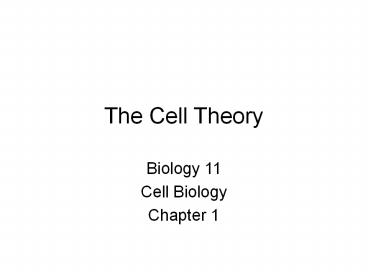The Cell Theory - PowerPoint PPT Presentation
Title:
The Cell Theory
Description:
The Cell Theory Biology 11 Cell Biology Chapter 1 The Cell pages 8-10 smallest living unit Basic building block of organisms Human body 100 trillion cells ... – PowerPoint PPT presentation
Number of Views:280
Avg rating:3.0/5.0
Title: The Cell Theory
1
The Cell Theory
- Biology 11
- Cell Biology
- Chapter 1
2
The Cellpages 8-10
- smallest living unit
- Basic building block of organisms
- Human body 100 trillion cells
- Different cells are specialized to preform
different tasks
3
Nerve Cells
- Transmit messages to the body about our
surroundings and enable us to respond. - Vision, hearing, taste, smell and touch all
depend on nerves.
4
Muscle Cells
- Capable of rapid contraction.
- Grouped together to form our muscle groups.
5
Red Blood Cells
- Transport of Oxygen
6
White Blood Cells
- Defense against disease.
7
Special Receptor Cells
- Communicate messages to nerves for relay to nerve
centres like the brain.
8
Our Body a living ecosystem of cells
- E. coli bacteria in our gut.
- We breathe in plant spores and pollen.
- Microbes and microscopic animal eggs on the food
we eat. - All made of cells!
- Outside has cells too fungus and bacteria.
9
Cells in Daily Life
- Yogurt bacteria
- Sour milk bacteria
- Cheese processing
- Yeast cells for bread and beer making
- Leather tanning processes
10
All cells
- Digest nutrients
- Excrete wastes
- Synthesize needed chemicals
- reproduce
11
Cells are.
- The basic unit of all living things!
- Grouped together to form tissues and organs.
12
Cell History
- Robert Hooke, 1665, borrowed the word cell
(reminded him of the cells in a monastery) to
describe the honeycomb shape and structure of a
thin slice of cork he observed under a primitive
microscope. - Robert Hooke
- Neglected Hooke
- Anton Van Leeuenhoek, 1674 An Unlikely
Scientist, made microcsopes and observed blood
cells, bacteria and single celled organisms. - Robert Brown, 1831, described the nucleus
- Theodor Schwann and Mathias Schleiden, 1838,
plant and animal tissue composed of cells - Louis Pasteur, Very Important Person!
studied microorganisms. - Rudolph VIrchow, 1858, All cells come from
preexisting cells.
13
Modern Cell Theory
- All living things are composed of one or more
cells. - The cell is the smallest entity that retains the
properties of life. - New cells arise only from cells that already
exist. - An expansion.More to the story!































